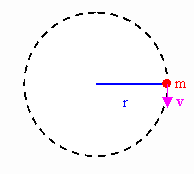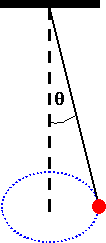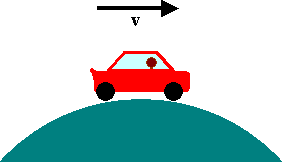
Review:
An object moving in a circle of radius r with constant speed v is accelerating. The direction of its velocity vector is changing all the time, but the magnitude of the velocity vector stays constant. The acceleration vector cannot have a component in the direction of the velocity vector, since such a component would cause a change in speed. The acceleration vector must therefore be perpendicular to the velocity vector at any point on the circle. This acceleration is called radial acceleration or centripetal acceleration, and it points towards the center of the circle. The magnitude of the centripetal acceleration vector is ac = v2/r.
Let us solve some problems investigating this question.
A 3 kg mass attached to a light string rotates on a horizontal frictionless table. The radius of the circle is 0.8 m and the string can support a mass of 25 kg before breaking. What range of speeds can the mass have before the string breaks?

Solution:
A coin placed 30 cm from the center of a rotating, horizontal turntable slips
when its speed is 50 cm/s.
(a) What force provides the centripetal acceleration when coin is stationary
relative to the turntable?
(b) What is the coefficient of static friction between coin and turntable?
Solution:
 Consider a conical pendulum with a 80 kg bob on a 10 m wire making an angle
of θ = 5o with the vertical. Determine
Consider a conical pendulum with a 80 kg bob on a 10 m wire making an angle
of θ = 5o with the vertical. Determine
(a) the horizontal and vertical component of the force exerted by the wire on
the pendulum and
(b) the centripetal acceleration of the bob.

Solution:
 An 1800 kg car passes over a hump in a road that follows the arc of a circle
of radius 42 m.
An 1800 kg car passes over a hump in a road that follows the arc of a circle
of radius 42 m.
(a) What force does the road exert on the car as the car passes
the highest point of the hump if the car travels at 16 m/s?
(b) What is the maximum speed the car can have as it passes this hump before
losing contact with the road?
Solution:

The only forces acting on the car moving with constant speed are gravity and the normal force, which is exerted by the road. If these forces are equal in magnitude, the car does not accelerate. If the car is moving on a circular arc, then it is accelerating. The acceleration is ar = v2/r. The gravitational force must therefore have a larger magnitude than the normal force.
Do you feel yourself thrown to either side when you negotiate a curve that is ideally banked for your car's speed? What is the direction of the force exerted on you by the car seat?
Discuss this with your fellow students in the discussion forum!
Massive objects have inertia. It takes a force to change their state of motion. All massive object interact via the gravitation force. A particle with mass m1 exerts a force F12 on a particle with mass m2. Newton's law of gravitation gives this force as
F12 = (-G m1m2/r122)
(r12/r12).
Here r12 is the distance between particles 1
and 2, and (r12/r12) is the
unit vector pointing from particle 1 to particle
2.
G is the gravitational constant, G = 6.67*10-11 Nm2/kg2.
The force F21, which the particle with mass m2 exerts on the particle with mass m1, is equal to -F12, according to Newton's third law. The gravitational force is always attractive.
 The point in an object from which the distance r12 is
measured is its center of mass. Mass m1 pulls on mass m2,
and mass m2 pulls on mass m1. The center
of mass of each object is pulled towards the center of mass of the other
object.
The point in an object from which the distance r12 is
measured is its center of mass. Mass m1 pulls on mass m2,
and mass m2 pulls on mass m1. The center
of mass of each object is pulled towards the center of mass of the other
object.
The radius of the earth is R = 6368 km. If you climb a 1000 m high mountain,
your distance from the center of the earth changes by (1/6368)*100 % = 0.016 %
and the magnitude of the gravitational force acting on you changes by (1/6368)2*100
% = 2.4*10-6 %. For all objects near the surface of the earth the
distance from the center is nearly constant, and the magnitude of the
gravitational force vector is therefore approximately constant. Over small
distances, when the curvature of the earth's surface can be neglected, the
direction of the gravitational force vector is also nearly constant. It points
straight downward towards the center of the earth.
The force of gravity on an object of mass m on the surface of the earth has
magnitude F = mg. Using Newton's law of gravity we write GMm/R2 =
mg, where M is the mass of the earth. We therefore have M = gR2/G.
Using R = 6.4*106 m, we find M = (9.8 m/s2)(6.4*106
m)2/(6.67*10-11 Nm2/kg2) =
6*1024 kg.
The gravitational attraction between an object and the earth pulls the object towards the center of the earth. When an object circles the earth, the direction of the gravitational force on the object constantly changes. The radius of the earth is so large, that the earth appears locally flat to an observer standing on the surface. When a problem involves only distances which are much smaller than the radius of the earth we often neglect the curvature of the earth's surface and assume that the gravitational force points in the same downward direction everywhere.
Link: The satellite as a projectile
 Assume that near the surface of the earth an object is thrown in the
x-direction as shown in the figure above. Initially it accelerates only in the
y-direction. But as the object moves, the direction of the acceleration
changes. If the objects initial speed is high enough, we have to take the
change in the direction of the force into account when calculating the objects
trajectory. An object in a circular orbit around the earth is
constantly falling towards the center of the earth. It is constantly
accelerating. But while it moves on a curved trajectory, the surface of the
earth curves away from the object so that the distance between the earth and the
object stays constant.
Assume that near the surface of the earth an object is thrown in the
x-direction as shown in the figure above. Initially it accelerates only in the
y-direction. But as the object moves, the direction of the acceleration
changes. If the objects initial speed is high enough, we have to take the
change in the direction of the force into account when calculating the objects
trajectory. An object in a circular orbit around the earth is
constantly falling towards the center of the earth. It is constantly
accelerating. But while it moves on a curved trajectory, the surface of the
earth curves away from the object so that the distance between the earth and the
object stays constant.
The force of gravity always points towards the center of the object's circular orbit and is responsible for the centripetal acceleration of the object.
F = mv2/r
For an object near the surface of the earth F = mg and r = 6.4*106 m. The speed of the orbiting object is found from mg = mv2/r, v2 = gr = (9.8 m/s2)(6.4*106 m). We have v = 7919 m/s, or approximately 8000 m/s. It takes the object t = 2πr/v = (6.28*6.4*106 m)/(7919 m/s) = 5075 s = 84 min to complete an orbit.
If the same object moved in a circular orbit with a larger radius, the force of gravity on the object would be smaller. As we double the distance from the center of the earth the force of gravity decreases by a factor of 1/4. The centripetal acceleration v2/r decreases by a factor of 1/4. This means that v2 must decrease by a factor of ½. We have v = 5600 m/s and it take 14355 s = 240 min to complete an orbit.
Objects in geo-synchronous orbits complete an orbit in 24 hours or 86400 s. Their speed is therefore is v = 2πr/(86400 s). Writing GMm/r2 = mv2/r = m(2πr/(86400 s))2/r, or r3 = GM(86400s)2/(4π). we can solve this equation for the radius of the geo-synchronous orbit. With M = 6*1024 kg we have r = 42260 km. A geo-synchronous satellite orbits about 42260 km - 6400 km = 35860 km above the surface of the earth. The radius of its orbit is 6.6 times the radius of the earth.
The moon orbits the earth once every 27.3 days. We can find the distance to the moon in the same way we found the distance to a geo-synchronous satellite. The earth-moon distance is 384400 km.
When a falling meteor is a distance above the earth's surface of 3 times the Earth's radius, what is its free-fall acceleration due to the gravitational force exerted on it?
Solution:
For more information about uniform circular motion motion, study this material from "the Physics Classroom".
Link: Motion Characteristics for Circular Motion
Link: Applications of Circular Motion